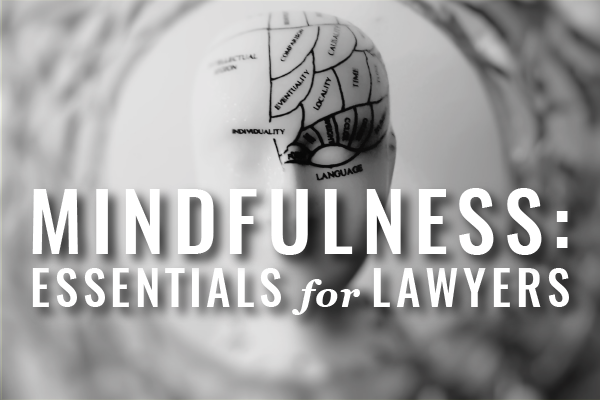The average human spends almost half of their waking hours thinking about something other than what is actually happening, according to a Harvard University study.
Mindfulness is paying attention to the present moment, intending to be curious and nonjudgmental about what you’re paying attention to. As a lawyer, it’s actually your job to think about past events and future events during many moments. It’s impossible and impractical to keep your thoughts glued to the current moment at all moments. As humans, our brains form habits without our awareness.
Practicing mindfulness helps you control how you spend your time and attention. If you want to improve any area of your life, mindfulness will probably help. There’s no shortage of benefits from work quality to physical health. We’ve all done things mindlessly — drove on autopilot, over-scrolled on social media. It doesn’t feel good.
Practicing mindfulness can even help reduce implicit bias, as Brenda Fingold of Brown University’s Mindfulness Center reminded the audience at the launch of Mindfulness in Law Society (MILS) in January 2019. You can find more on that from UC Berkeley here. Every lawyer needs to take active steps to reduce their implicit biases. MILS is growing divisions and chapters across the country — find more on joining here.
If you wait to start, you might not start. Pick at least one way to practice when you’re done reading — or pause as you read to practice. In all its glorious simplicity, mindfulness can appear overwhelming in a culture that simultaneous hypes its efficacy and seeks to distract us more. The good news is that no matter how long you’ve gone without practicing mindfulness, you’ll feel better when you start.
And mark your calendar now for Mindful Mondays! Each Monday at 4pm, MILS hosts a free 30-minute “virtual sit” online via Zoom. Here’s more. You don’t have to join MILS to join Mindful Mondays.
N O T I C I N G .
Taking a moment to focus on the experience of one or more of your physical senses can allow your mind to vacate the unknown future and appreciate the present moment. What can you see, hear, smell, taste, and feel? By doing so, anxious feelings will decrease for as long as you are focusing on the present moment.
Focusing on something as easy as breathing is not so easy but does get easier. Every time you get distracted, you can refocus. And every time you refocus, you’ll improve your focus endurance. Every time.
5 Ways to Practice Mindfulness by Noticing:
- Notice your breath. Feel the air enter and move through you. Each time your mind wanders, return to the sensations of your breathing.
- Practice mindful eating. Pay attention to the tastes, sights, textures, smells, and sounds of your food. Don’t inhale your food for energy just to jump back into work, experience and enjoy your food.
- Notice your well-traveled route or usual environment. Pay attention to the details that you normally ignore. Scan your environment and choose which of the sights, smells, and sounds you want to focus on.
- Notice sounds. Pay attention when you hear sound mixtures around you and listen long enough to isolate and focus on individual elements of the sounds in the mix.
- Do full body scans or stretching. Pay attention to your body, processing areas from bottom-up or top-down, notice pain or tension and relax muscles as you proceed. Or, schedule at least one time each day to stretch, and notice the physical feeling prior to, during, and after stretching.
BIG TIP: Anchor your Activity! For easier habit forming, incorporate your mindfulness practice into your day by tying it to a must-do. When you step outside for the first time each day, focus on something you see or hear. When you enter your car, do a full body scan before driving. When you go to the bathroom, notice your muscles as you move. Commit (at least!) one meal or snack each to focus on eating it mindfully.
R E A C T I N G .
One goal of mindfulness is to have better awareness and control of our emotions. As soon as you notice that you’re reacting to a stressor, use the STOP Practice, which Brenda shared at the MILS launch along with a list of personal stress warning signals. You can find a similar list here — concentrate on knowing yourself.
- STOP. Intentionally pause.
- Take a Breath. Take a slow, deep breath low into your belly (we know it really goes to your lungs) — or two, feeling it move through your body.
- Observe. What is happening to you right now? What body sensations can you feel? What emotions can you feel? What thoughts are entering your mind? What urges and behaviors are happening? Simply notice what’s happening without seeking to judge or fix.
- Proceed. Discern what is called for now from the direct experience of the moment. Acknowledge your feelings but disengage old thought patterns about them. Notice if by adding space for awareness, your experience is different than in the past and you feel more able to control your response.
Conversations often involve potential stressors. Practicing mindful conversations will help you stay in the present moment and also improve your relationships. Use these tips:
- Don’t try to multitask (trying to listen while also review a to-do list in your head does not work)
- Listen to the words that the other person is saying (this is hard; our brains process speech significantly faster than we speak)
- Notice the tone, volume, and intonation of those words
- Try to identify the emotions being expressed through those words
- Notice when you do not understand something and ask clarifying questions
- Paraphrase what you have heard and ask if it is accurate
- Reflect the emotions that you noticed and validate those emotions
- Share your thoughts in response
M E D I T A T I O N .
When you’re practicing mindfulness with your thoughts alone, it gets a special name called meditation. To meditate, you don’t focus on your air flow but on your thought flow. The goal is not to process thoughts as usual, and not to judge yourself for having the thought, but simply to observe the thought and let it pass.
Here are some guided meditations from UCLA — but personally, I think there’s more of a barrier to entry with meditation. I don’t want to generalize lawyers, but it might be fair to say that they have deep habits of judging. I practice mindfulness A BUNCH, but I RARELY meditate. I suspect practicing mindfulness might eventually ripen me for full-on meditation but I’m not here to rush. That said, humans are different and you might love meditation.
. . .
This post was compiled and updated from two earlier posts by Shawn Healy, Phd: How to Practice Mindfulness and Reduce Anxiety and Practice Mindfulness Amid the Chaos.




